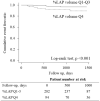Determinants of Non-calcified Low-Attenuation Coronary Plaque Burden in Patients Without Known Coronary Artery Disease: A Coronary CT Angiography Study
- PMID: 35463764
- PMCID: PMC9021435
- DOI: 10.3389/fcvm.2022.824470
Determinants of Non-calcified Low-Attenuation Coronary Plaque Burden in Patients Without Known Coronary Artery Disease: A Coronary CT Angiography Study
Abstract
Background: Although epicardial adipose tissue (EAT) is associated with coronary artery disease (CAD), it is unclear whether EAT volume (EAV) can be used to diagnose high-risk coronary plaque burden associated with coronary events. This study aimed to investigate (1) the prognostic impact of low-attenuation non-calcified coronary plaque (LAP) burden on patient level analysis, and (2) the association of EAV with LAP volume in patients without known CAD undergoing coronary computed tomography angiography (CCTA).
Materials and methods: This retrospective study consisted of 376 patients (male, 57%; mean age, 65.2 ± 13 years) without known CAD undergoing CCTA. Percent LAP volume (%LAP, <30 HU) was calculated as the LAP volume divided by the vessel volume. EAT was defined as adipose tissue with a CT attenuation value ranging from -250 to -30 HU within the pericardial sac. The primary endpoint was a composite event of death, non-fatal myocardial infarction, and unstable angina and worsening symptoms requiring unplanned coronary revascularization >3 months after CCTA. The determinants of %LAP (Q4) were analyzed using a multivariable logistic regression model.
Results: During the follow-up period (mean, 2.2 ± 0.9 years), the primary endpoint was observed in 17 patients (4.5%). The independent predictors of the primary endpoint were %LAP (Q4) (hazard ratio [HR], 3.05; 95% confidence interval [CI], 1.09-8.54; p = 0.033] in the Cox proportional hazard model adjusted by CAD-RADS category. Cox proportional hazard ratio analysis demonstrated that %LAP (Q4) was a predictor of the primary endpoint, independnet of CAD severity, Suita score, EAV, or CACS. The independent determinants of %LAP (Q4) were CACS ≥218.3 (p < 0.0001) and EAV ≥125.3 ml (p < 0.0001). The addition of EAV to CACS significantly improved the area under the curve (AUC) to identify %LAP (Q4) than CACS alone (AUC, EAV + CACS vs. CACS alone: 0.728 vs. 0.637; p = 0.013).
Conclusions: CCTA-based assessment of EAV, CACS, and LAP could help improve personalized cardiac risk management by administering patient-suited therapy.
Keywords: chronic coronary syndrome (CCS); coronary CT angiography; coronary artery calcium score; epicardial adipose tissue; high-risk plaque; prognosis.
Copyright © 2022 Yamaura, Otsuka, Ishikawa, Shirasawa, Fukuda and Kasayuki.
Conflict of interest statement
The authors declare that the research was conducted in the absence of any commercial or financial relationships that could be construed as a potential conflict of interest.
Figures




Comment in
-
Commentary: Plaque Features and Epicardial Fat Volume for Cardiovascular Risk Assessment-A Key Role With Cardiac Computed Tomography?Front Cardiovasc Med. 2022 Apr 29;9:896321. doi: 10.3389/fcvm.2022.896321. eCollection 2022. Front Cardiovasc Med. 2022. PMID: 35571220 Free PMC article. No abstract available.
Similar articles
-
High levels of pericoronary adipose tissue inflammation are associated with coronary atherosclerosis independent of epicardial adipose tissue volume in patients with chronic coronary syndrome.Eur Heart J Imaging Methods Pract. 2025 Jun 10;3(2):qyaf079. doi: 10.1093/ehjimp/qyaf079. eCollection 2025 Jul. Eur Heart J Imaging Methods Pract. 2025. PMID: 40636778 Free PMC article.
-
Prognostic Value of RCA Pericoronary Adipose Tissue CT-Attenuation Beyond High-Risk Plaques, Plaque Volume, and Ischemia.JACC Cardiovasc Imaging. 2021 Aug;14(8):1598-1610. doi: 10.1016/j.jcmg.2021.02.026. Epub 2021 May 3. JACC Cardiovasc Imaging. 2021. PMID: 33958312
-
Thoracic Aortic Plaque Burden and Prediction of Cardiovascular Events in Patients Undergoing 320-row Multidetector CT Coronary Angiography.J Atheroscler Thromb. 2024 Mar 1;31(3):273-287. doi: 10.5551/jat.64251. Epub 2023 Sep 27. J Atheroscler Thromb. 2024. PMID: 37704429 Free PMC article.
-
Comparative Prognostic Value of Coronary Calcium Score and Perivascular Fat Attenuation Index in Coronary Artery Disease.J Clin Med. 2024 Sep 2;13(17):5205. doi: 10.3390/jcm13175205. J Clin Med. 2024. PMID: 39274418 Free PMC article. Review.
-
Cardiac Computed Tomography Angiography in CAD Risk Stratification and Revascularization Planning.Diagnostics (Basel). 2023 Sep 11;13(18):2902. doi: 10.3390/diagnostics13182902. Diagnostics (Basel). 2023. PMID: 37761268 Free PMC article. Review.
Cited by
-
The Role of Epicardial Adipose Tissue in Acute Coronary Syndromes, Post-Infarct Remodeling and Cardiac Regeneration.Int J Mol Sci. 2024 Mar 22;25(7):3583. doi: 10.3390/ijms25073583. Int J Mol Sci. 2024. PMID: 38612394 Free PMC article. Review.
-
Impact of epicardial adipose tissue on diastolic dysfunction in patients with chronic coronary syndrome and preserved left ventricular ejection fraction.Eur Heart J Imaging Methods Pract. 2024 Jun 5;2(1):qyae056. doi: 10.1093/ehjimp/qyae056. eCollection 2024 Jan. Eur Heart J Imaging Methods Pract. 2024. PMID: 39224094 Free PMC article.
-
The Roles of Coronary Computed Tomography Angiography in Characterizing Coronary Plaque: Screening, Treatment, and Prevention.J Cardiovasc Dev Dis. 2023 Jan 24;10(2):43. doi: 10.3390/jcdd10020043. J Cardiovasc Dev Dis. 2023. PMID: 36826539 Free PMC article.
-
Impact of diabetes mellitus and triglyceride glucose index on mortality and cardiovascular outcomes in patients with chronic coronary syndrome undergoing coronary computed tomography angiography.Int J Cardiol Cardiovasc Risk Prev. 2024 Feb 24;20:200250. doi: 10.1016/j.ijcrp.2024.200250. eCollection 2024 Mar. Int J Cardiol Cardiovasc Risk Prev. 2024. PMID: 38476976 Free PMC article.
-
Predictive value of the perivascular fat attenuation index for MACE in young people suspected of CAD.BMC Cardiovasc Disord. 2025 Feb 5;25(1):80. doi: 10.1186/s12872-024-04401-0. BMC Cardiovasc Disord. 2025. PMID: 39910435 Free PMC article.
References
-
- Shaw LJ, Berman DS, Maron DJ, Mancini GBJ, Hayes SW, Hartigan PM, et al. . Optimal medical therapy with or without percutaneous coronary intervention to reduce ischemic burden: results from the clinical outcomes utilizing revascularization and aggressive drug evaluation (COURAGE) trial nuclear substudy. Circulation. (2008) 117:1283–91. 10.1161/CIRCULATIONAHA.107.743963 - DOI - PubMed
LinkOut - more resources
Full Text Sources
Research Materials
Miscellaneous

